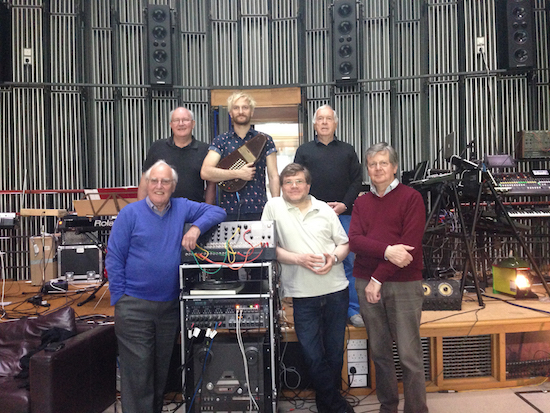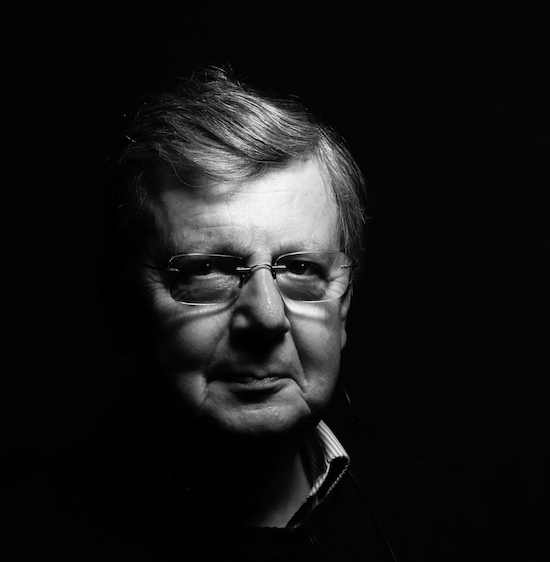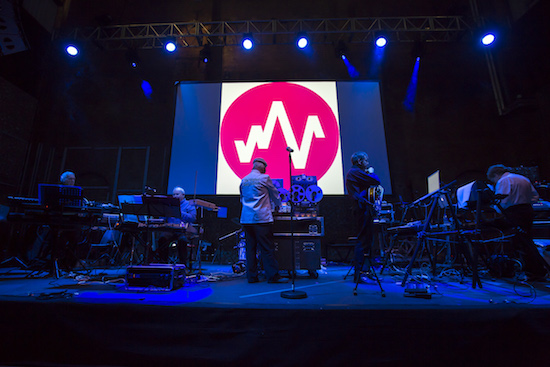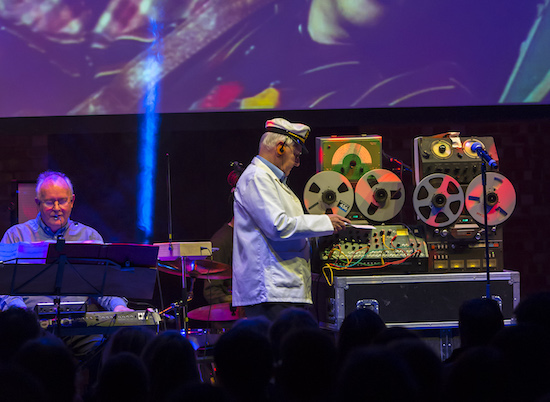The Radiophonic Workshop used to attach light blue leader tape to their material so that people inside the BBC knew where these sounds and compositions had originated. It was a funny little trademark that always gave away the hand of the Workshop when it was upon something. My first flourish in the music industry was as part of the psychedelic folk acts Agincourt and Ithaca. The albums we made are, I think, now considered rare and precious by the record collecting community but they remain period pieces to me.
As with most musicians I had to find a day job, ideally something that was not too far from the kind of creative life I wanted, so I joined the BBC as a studio manager in 1970.
As I lined up reels of tape to broadcast I noticed that whenever one had a light blue leader, something strange and extraordinary emerged from the speakers. The blue leader meant surprise and transport to another place. Strange, sometimes disturbing, fresh and often humorous but never dull. I became fascinated with the thought that this sound, whatever it might be, only ever existed within the confines of the medium of tape. If you had been in the room when this was created, the only way you could magic it into existence was through a loudspeaker. It was purely electronic, synthetic, new. There was something in the wire, almost like the sculptor whose work of art already exists in the stone that he or she is chipping away at trying to reveal. The sound was a composite of all the electrons dancing in the waves, and we were privileged to have discovered it.
Discovering sounds, as I was to find out when I moved across to the Radiophonic Workshop in 1974, was no easy task. Back in the early 70s almost all of the equipment had been designed for something else and was often about to be thrown away. After all, an electro acoustic music lab was not commonplace and you had to beg steal and borrow gear from anywhere you could. The work was regarded as so weird that early members of staff were encouraged not to do it for too long, to protect their ears and their sanity. But for those of us willing to take the chance, the rewards were great. There was something very satisfying about conjuring up atmospheric and often emotional sounds out of brute machines that without our efforts would have ended up on a scrap heap.
There is no doubt that the sound and feel of the early music produced at The Radiophonic Workshop was compromised by the technology on offer. Purists would like to think that so impeccable was the inspiration behind every piece, that the result had to be in every way precisely what was intended. No. Tape hiss, for example, was so loud after many layers of sound were recorded that heavy filtering of the top frequencies was essential, leading to the plummy sounds that are typical of the period. The choices on offer on older gear were very limited. Constantly variable controls were rare and often only predetermined step changes were possible. But perhaps those restrictions were sometimes a benefit. It is often easier to be creative with more restricted terms of reference.

But the excitement in teasing art from technology, especially such ageing technology, did have its down side. For anyone with all the time in the world to create their masterpiece, the unwanted hums buzzes and clicks could eventually be conquered, but for us with a deadline looming, it was another matter. The Radiophonic Workshop was always a service department, our very existence relied on us contributing to broadcast output and on a regular basis. We did not have the luxury of studios like IRCAM in Paris where somehow the quality of a piece was commensurate with the time taken to create it – we were really on the front line. I remember on several occasions deciding to finish work early, only to return home and see an advert on BBC One for the very programme I was desperately trying to finish at work. It was always us and the machines against the world. So what was and still is our relationship with these insensitive bits of gear?
There are two sorts of relationship that we can have with technology that will enable us to be creative.
The equipment can either be our servant or our partner.
As a servant it dutifully does as it is told. We have the ideas and look around for something that can bring them to fruition, in much the same way that classical and contemporary composers write a score for known instruments to play. As they are imagining the work in their heads, they are not just imagining the sounds but also seeing the instruments that will play them. Composers of electronic music are never in that position and don’t want to be. Our relationship is of the second order.
For us, technology is a partner. Sure we have initial ideas based on the discussion with the director and are fairly confident about which piece of gear or software might be able to deliver what we are looking for, but there always comes a point when your decisions are affected by an unexpected contribution from the technology itself. If yours is a master servant relationship, then at that point you would immediately try and stop this errant piece of shit not doing what it is told, and pull it back into line. However, if you are in partnership with the technology then you weigh up what it is offering. Perhaps this new departure has made you realise that your first ideas were too narrow. Now you are seeing an amazing creative vista opening up, thanks to this technical intervention. "That’s a great idea," you might say, "but can you do it this way?" Immediately, your creative journey has taken a fork in the road that you would never have seen had you stuck doggedly to the straight road that you had planned.
Clearly, in the early days the excitement of using the gear in this way was somewhat tempered by its ability to function properly. I know that one of the reasons for Delia Derbyshire’s departure from the workshop was her frustration with the equipment. It was still in the era of beg steal and borrow. Before The Radiophonic Workshop had its own budget a lot of our time was spent chasing faults. You would be finishing a perfect mix and as the reverberation died away there would be an almighty click in the reverb chain which meant that the click itself was reverbed. In those circumstances you would be forgiven for thinking that far from the gear being a partner, it was your sworn enemy.

Peter Howell
I had this particular problem on a regular basis during one period at the workshop. I had just taken up residence in a new studio towards the centre of the building. These clicks would drive me and our engineers mad as we desperately tried to trace their source. Rewiring and re-earthing of countless bits of gear proved ineffective. Eventually they discovered that these sometimes rhythmic clicks were generated by the beacon from Heathrow airport which coincidentally beamed across the back of the BBC building. Once you allow yourself to become immersed in the world of electronics you have to be prepared for anything, good and bad. Somehow, despite all the setbacks, you start to see how to use the qualities of this world to your advantage and produce something new and effective. This is the goal, and although today we have solved many of the challenges of the early pioneers, we have now immersed ourselves in the digital world and have once again discovered that this new partner brings with it a whole new set of benefits and challenges.
Of course it would be ridiculous to suggest that this marrying of art and science is anything new. I am sure that every artist through history has been equally preoccupied with the means as well as the idea. Painters need to know about colours and how to mix and apply them, sculptors about the nature of the material they are working with, but it is only in areas where the nature of the art can be expressed away from the performance of it. It is in these pretentious realms that the elitist artist seems to flourish. When I first started in the industry, composers, musicians and conductors would be expected to occupy the studio, whereas producers and engineers would be more at home in the control room. The fact that I was able to talk to the musicians and the engineers was regarded as a sort of showing off. Of course these days such a breadth of knowledge is commonplace and expected. In fact, now that The Radiophonic Workshop is touring as a band and collaborating with other artists, our knowledge of the technology is common ground; a ‘safe’ starting point for any further discussion about artistic content. Clearly each member of a collaboration will bring a special insight and style to the table, but the way we use software and hardware is often a good place to start.
One thing that might cause us to resort to discussing the technology when working with another artist for the first time is the sheer scale of what is now on offer creatively. When everything is possible nothing is achieved, only when the context of the piece has been decided can we really move on. In partnership with the technology, and in response to the brief, you can start to form a really solid idea of where you are going. There will come a time with all these items in place when the piece you are composing turns the tables and starts to demand things from you – then you really are flying. That’s where the wings come in handy… but you’ve got to know how to use them.
The Radiophonic Workshop play the British Library this Friday as part of their Season Of Sound. For more information, go here. The Radiophonic Workshop’s Burials In Several Earths
album is out now



